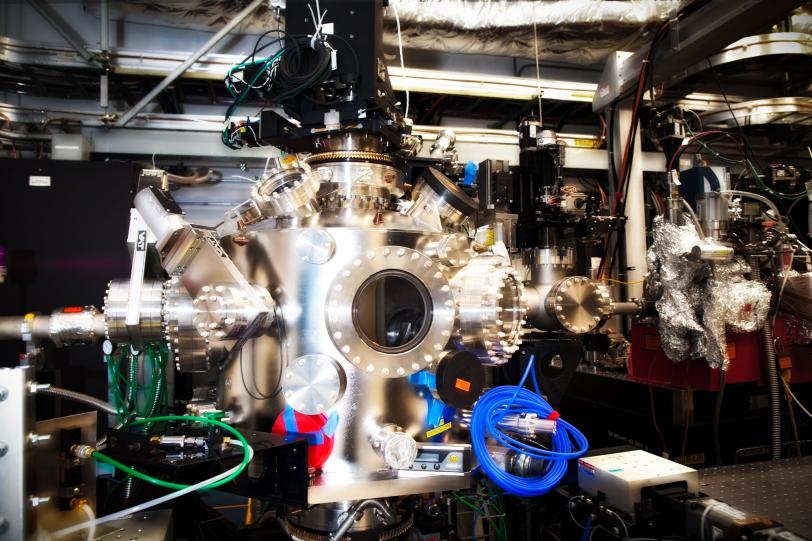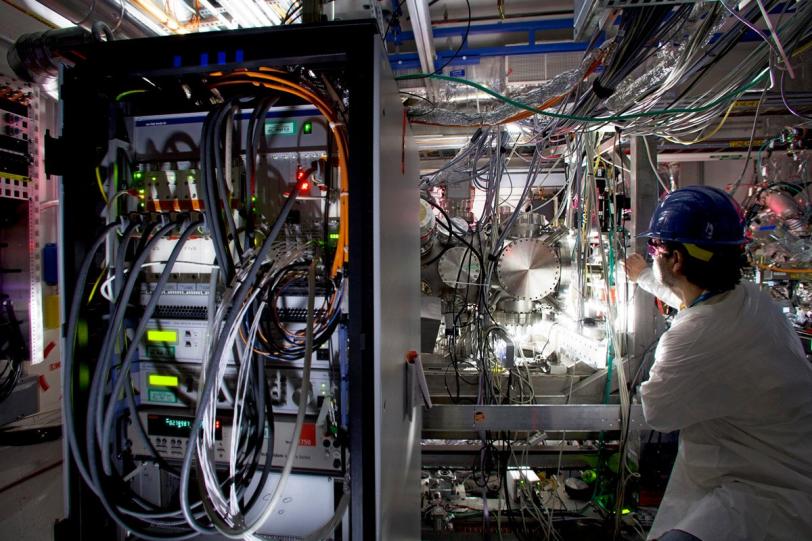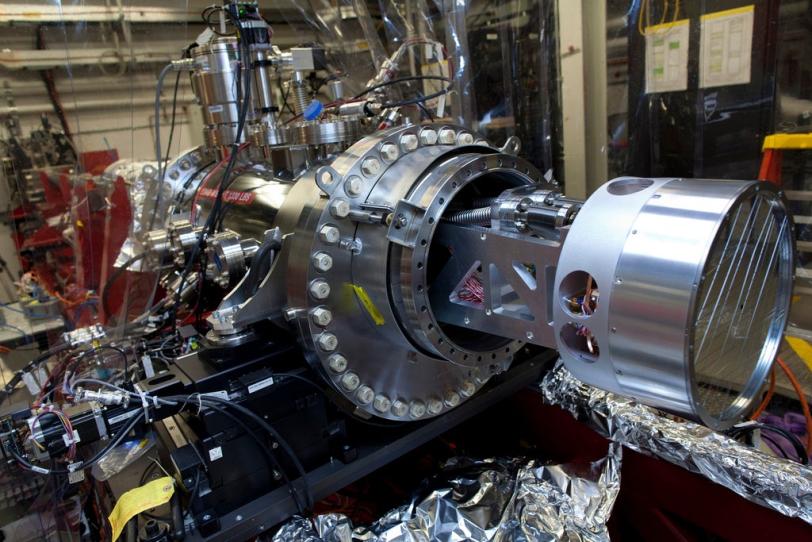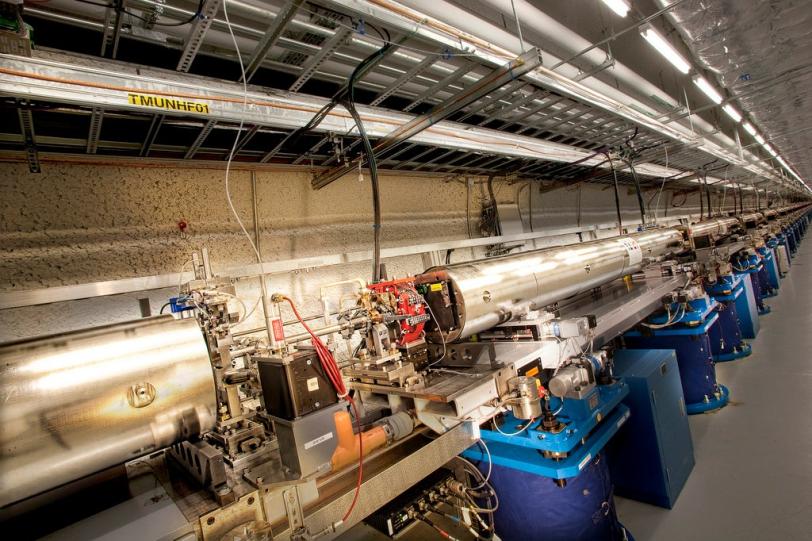LCLS Ramps Up for Fourth Experimental Run
Shutdown doesn't mean slow down for workers at SLAC National Accelerator Laboratory's Linac Coherent Light Source, LCLS.
By Mike Ross
Shutdown doesn't mean slow down for workers at SLAC National Accelerator Laboratory's Linac Coherent Light Source, LCLS.
With three successful experimental runs completed at the world's most powerful X-ray laser, scientists turned off the X-ray beam in March so they could install and maintain equipment, make improvements and prepare for the next run of experiments.
As a result, researchers using LCLS starting June 9 will enjoy increased capabilities, from eight new conventional lasers to a one-ton crane for moving heavy equipment. They'll also have full use of the Coherent X-ray Imaging instrument, CXI, which was drafted into service for three experiments at the end of the last run and is now being outfitted with a full suite of mirrors and other equipment for its official start-up in June. It's the fourth of six LCLS instruments to become operational; two more are being readied for action.
"We are very excited that CXI has joined the other LCLS instruments in being ready for users," said Uwe Bergmann, LCLS deputy director. "Soon we'll have the full complement of six instruments available. In fact, in our review meeting earlier this month, for the first time we accepted user proposals for all six LCLS instruments."
LCLS is pioneering the use of X-ray laser pulses to reveal the three-dimensional structures of a wide variety of materials, including previously intractable biological objects, with an eye toward creating the world's first atomic-scale "molecular movies" showing chemical reactions as they happen.
Right from the start, LCLS has exceeded expectations. Since it opened for research in October 2009, operators have steadily pushed the machine to obtain shorter pulse lengths – now down to 5 femtoseconds, or millionths of a billionth of a second – and pulse energies up to 10,000 electronvolts. To date, nearly 1,300 scientists from 28 countries have proposed experiments. Sixty groups were accepted during the first three runs and 27 more are scheduled for beam time during the fourth run. LCLS researchers have published more than 40 pioneering technical publications, with many more in progress. Seven have appeared in the high-impact journals Science and Nature, including breakthrough papers on a new way to determine the structures of proteins that are difficult or impossible to crystallize, the first detailed images of an intact virus and a technique for knocking out inner electrons to create hollow atoms.
Upgrades for Run Four
Here's a rundown of the shutdown activities at all six LCLS instruments, and a look forward toward a few of their upcoming user experiments:
During this three-month shutdown, staff at CXI is installing a set of mirrors to focus the X-ray beam down to a 1-micron spot, as well as a large pixel-array detector, 16 centimeters on a side, to record the X-ray scattering from samples varying from micron-sized protein crystals to nanometer-scale particles. CXI is the second LCLS instrument to use so-called hard X-rays, which by virtue of their very short wavelengths can be used to locate the positions of individual atoms – critically important in understanding virtually all biological, chemical and physical processes.
Among the six experiments slated for CXI during the next run, two aim to determine how a manganese-calcium complex in green plant cells splits water molecules, creating over the eons virtually all of the oxygen in our atmosphere. Researchers will squirt cells encased in water past a conventional laser pulse, which excites the complex much as sunlight would, and then zap them with an ultra-short pulse from the X-ray laser beam. Stop-action X-ray diffraction will reveal precise atomic positions within the complex, while X-ray emissions identify individual chemical elements. Combining the data from many millions of images should yield detailed maps of the complex as it cleaves water molecules into hydrogen and oxygen – information central to creating artificial photosynthesis for producing sustainable, clean energy.
The technique used in these experiments is called "pump-probe." First, scientists initiate changes in a sample by exciting, or pumping, it with an ultra-short pulse of light. Then, a fraction of a split second later, they probe the sample with pulses from a second laser beam to see what happened. At the LCLS, samples are most often pumped with optical light, then probed with the X-ray laser beam to create a stop-action image of the atomic positions at the instant the X-rays strike the sample.
The first hard X-ray instrument at LCLS, known as XPP for X-Ray Pump Probe, completed its first full run of experiments earlier this year. Now XPP instrument scientist David Fritz is ticking items off a laundry list of 141 shutdown tasks. "We're moving some things around and will have to recommission them," Fritz said, referring to the exacting process of assuring that an LCLS component works as intended and does not adversely affect any other instruments.
One upcoming experiment at XPP aims to see how atoms in solids move during the mere instants just prior to a phase transition, such as melting.
Fritz is also collaborating on the development of a device to measure the relative arrival time between each of LCLS's ultra-short less-than-100-femtosecond-long X-ray pulses and the optical laser pulses. Since photons travel a full micron in just 3 femtoseconds, even the expansion and contraction of experimental equipment from day-night temperature variations can alter the timing of laser pulses, which is critical for many LCLS experiments. Precise timing information will allow scientists to adjust the machine in real time to keep the pulses in sync, as well as process data from their experiments more accurately.
Over at the Soft X-Ray Materials Science instrument, SXR, a one-ton overhead crane is a welcome addition. The SXR became operational last May. As a concession to an aggressive SXR launch schedule, the crane installation was postponed until this shutdown, said Bill Schlotter, SXR instrument scientist. "We move a lot of heavy pieces of equipment in and out," Schlotter said. "With our own overhead crane, these moves will now be much easier, faster and cheaper. Plus we'll have more time to prepare – and sleep – between experiments."
Other additions to SXR include a larger laser table to improve the instrument's laser capacity, a more user-friendly control room with three new computers and a reorganized network rack that tamed hundreds of unwieldy cables.
Upcoming experiments at SXR will investigate details of electron transfer in solar cells and unusual stripes of electric charge that form in some high-temperature superconductors. Scientists hope more detailed knowledge of these stripes will help them understand why the exotic materials conduct electrical current with 100 percent efficiency, and will guide them toward creating new materials that superconduct at closer to room temperature.
At LCLS's first operating instrument – Atomic, Molecular & Optical Science, or AMO – the current shutdown is fairly quiet. "Our technicians will be very busy throughout the entire run, however, since each of our experiments requires modifications," said instrument scientist John Bozek. For example, for one experiment the staff will install a spectrometer provided by the scientist who is conducting the study, and then remove it when the experiment is done.
After the LCLS restarts, scientists plan to use the AMO to explore a new way to create an X-ray laser, a specialized camera to image ultra-short LCLS X-ray pulses and an exotic X-ray holography technique for making 3-D molecular movies of chemical reactions in progress.
Two more LCLS instruments being readied in the wings
XCS, the X-ray Correlation Spectroscopy instrument, begins commissioning soon, and activity there is intensifying. "When our first experiments begin in November, we want to be sure that everything works," said XCS instrument scientist Aymeric Robert.
A unique feature of XCS is its "split and delay" line, which creates pairs of X-ray pulses with adjustable separations ranging from 100 femtoseconds to several nanoseconds. Researchers will use the pulse pairs to take rapid-fire, stop-action X-ray images and perform the world's first atomic-scale dynamic studies of disordered materials, such as liquids and metal alloys.
Commissioning for the final instrument, Matter in Extreme Conditions or MEC, begins in November and is expected to finish in August 2012, according to Bob Nagler, MEC instrument officer. The instrument's two lasers – one high-power, the other high-energy – will heat solid samples to temperatures as high as 100,000 Kelvin and subject them to nearly two million times atmospheric pressure during the instant they are illuminated by LCLS X-rays. During the shutdown, workers are installing a large vacuum chamber, 2 meters in diameter and 1.5 meters high.
Last week saw the highly anticipated arrival of two large-offset monochromators – devices designed to peel off a portion of the LCLS X-ray laser pulse and deliver it to an instrument while the remainder continues down the beamline to another instrument. Once the monochromators are installed and commissioned – one each at the XPP and XCS – scientists may be able to conduct experiments at more than one of LCLS's hard X-ray instruments at a time, expanding its capacity to do science.
“Our staff is making great progress during this shutdown toward our goal of creating more refined X-ray pulses and giving our users additional X-ray instruments,” said Joachim Stöhr, LCLS director. “We have already earned a worldwide reputation based on scientific discoveries in our early user phase and I know of yet unpublished scientific results which are equally exciting. The ongoing improvements in capabilities and capacity will enhance our value to the worldwide scientific
LCLS Instruments At-a-glance
| AMO: Atomic, Molecular and Optical Science Location: Near Hall; Hutch 1 (Blue) Status: The LCLS’s first operating instrument; commissioned September 2009 Specialty: Intense, ultra-short pulses of soft X-rays. Shutdown work: Relatively minor Upcoming experiment: Explore an exotic X-ray holography technique for making 3-D molecular movies of chemical reactions in progress. | XPP: X-ray Pump Probe Location: Near Hall, Hutch 3 (Green) Status: Commissioned October 2010 Specialty: Hard X-rays. Shutdown work: A large-offset monochromator arrived in May. This device peels off a portion of the main X-ray beam for delivery to an instrument. Upcoming experiment: Detailing atomic motion during the instants prior to a phase transformation, such as melting. | |
| CXI: Coherent X-ray Imaging Location: Far Hall; Hutch 5 (Red) Status: Newest instrument. First experiment took place during commissioning this past February. Specialty: Hard X-rays. Shutdown work: Adding a 8-square-centimeter pixel array detector and a set of mirros that will focus the X-ray beam down to a 1-square-micron spot Upcoming experiment: Determining how a manganese-calcium complex in green plant cells splits water molecules to create the oxygen we breathe | SXR: Soft X-ray Materials Science Location: Near Hall; Hutch 2 (Black) Status: Began operation in May 2010 Specialty: Monochromator narrows the energy spread of soft X-rays delivered to experiments. Diverse and flexible instrumentation. Shutdown work: Installing an overhead crane for moving heavy equipment; adding a larger laser table; improving control room and network rack. Upcoming experiment: Looking at stripes of electrical charge in high-temperature superconductors; aimed at learning how to design materials that conduct electricity with 100 percent efficiency at even warmer temperatures | |
| XCS: X-ray Correlation Spectroscopy Location: Far Hall; Hutch 4 (Purple). Status: Begins commissioning soon; first experiments in late 2011. Specialty: Hard X-rays. A “split-and-delay” line creates pairs of X-ray pulses separated by 100 femtoseconds to several nanoseconds that will be used to take pairs of stop-action images of the same sample. Shutdown work: A large-offset monochromator arrived in May and will be installed. This device peels off a portion of the main X-ray beam for delivery to an instrument. Upcoming experiments: None yet. | MEC: Matter in Extreme Conditions Location: Far Hall; Hutch 6 (Yellow). Status: Commissioning begins November 2011. Specialty: Hard X-rays. Two lasers will heat and compress solid samples to very high temperatures and pressures during the instant they are hit by the X-ray laser beam. Shutdown work: Installing large vacuum vessel. Upcoming experiments: None yet. |



